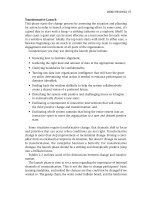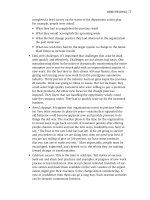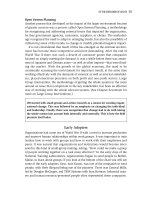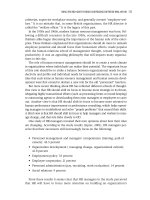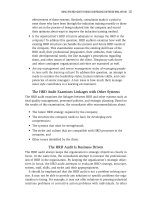Practicing Organization Development (A guide for Consultants) - Part 43 pptx
Bạn đang xem bản rút gọn của tài liệu. Xem và tải ngay bản đầy đủ của tài liệu tại đây (218.93 KB, 10 trang )
S What is SO? What is the situation now? (In as much vivid detail as
possible.)
T What is the TARGET or TRANSFORMATION? What will things be like
when they are perfect? (Again in vivid detail.)
R What are the REASONS you are not there now? What RESOURCES
are present, supporting your intended breakthrough? (This is basi-
cally a force field of the situation.)
What are the RATIONALIZATIONS that are keeping things stuck?
I What are the major ISSUES that you know will have to be addressed?
(What have been the “dead horses on the table” that have been diffi-
cult to admit or discuss?)
P What POLARITIES are present and not being managed well? (Where
are you positional about something, holding it as an either/or when it
might be a both/and? What are the potential benefits of the position
you have been resisting or avoiding?)
E What will be EVIDENCE OF SUCCESS? (How will you recognize that
movement is taking place? What will be the first signs?)
S What is a FIRST STEP you could take which, itself, would be a small
breakthrough? (When will you take that step?)
Coaching as Appreciative Inquiry
For the via positiva, we use appreciative inquiry, a relatively recent addition to
our OD technology, as an example. AI, as it is known, is based on a philosophy
and practice that engage the client in an inquiry about what is working. (See
Chapter Twenty-Two for more on AI.) An AI coach works in ways that are a
sharp contrast to the traditional problem-solving or expert model of coaching.
Some guiding principles of AI follow:
• Words create worlds: For example, the word “issue” is replaced with a
more neutral or even affirmative label, “topic.” What is focused on
becomes reality. Reality is created in the moment an experience is
“named” in the act of perceiving it—and there are multiple realities,
brought into existence by the language used to describe what is
happening.
• Inquiry creates change: The very first question begins the change process
and influences the client in one way or another. AI questions are open,
invite rapport—not report—and provide space for the person to swim
around in a topic he or she may not have thought about before.
PERSON-CENTERED OD INTERVENTIONS 391
22_962384 ch15.qxd 2/3/05 12:23 AM Page 391
• Life provides an endless opportunity for learning: Once someone enters
the AI process, everything that happens to him or her can become “grist
for the mill” of learning.
• Image inspires action: Developing a strong, visceral image of a passion-
ately desired future helps the person to want to start living it.
• The more positive the coach’s questions, the greater the willingness to
take action, and the longer lasting the change: The most powerful ques-
tions call forth and affirm the positive core of the person, for example,
“What do you value most about what you are able to contribute when
you are at your best?”
• Wholeness brings out the best in people: People make the most progress
when what they are doing integrates all aspects of their lives, bodies,
minds, and spirits.
• The past is a powerful source of wisdom and energy for the future: Peo-
ple are more ready to journey into the future (the unknown) when they
carry forward the best parts of the past (the known).
• Choosing liberates personal power: Personal development, AI style, is all
about choice. The clients choose what to focus on, their image of the
future, and their options for getting there.
The appreciative inquiry process is very simple and moves the client from
the past to the future in a powerful way. The general steps, in sequence, are
1. DISCOVER—The client is invited to take an in-depth look back at what
has worked in the past and forward to hopes and wishes for the future.
Prior to this step, the client is helped to be very specific about the situ-
ation he or she wants to see changed. For example:
AI Coach: “You say you want to do a good job leading this layoff and
you are scared. OK. Imagine that the layoff is over. What are one or
two specific outcomes of the layoff that would make you proud and
amazed?”
AI Client/Leader: “Every employee who had to leave left feeling
respected and ready for the unknown, and those who survived are
ready and excited about moving ahead with the company.”
2. DREAM—Building on the best of the past, the client translates his or
her greatest hopes and wishes for the future into a statement. Written
in the present tense, as though the future is actually happening, the
statement needs to stretch and challenge, be exciting and something
the person really wants. “If everything in this situation were perfect,
what would be happening?”
392 PRACTICING ORGANIZATION DEVELOPMENT, 2ND EDITION
22_962384 ch15.qxd 2/3/05 12:23 AM Page 392
3. DEFINE—Working together, the client and the consultant pinpoint
exactly where the focus of the intervention will be, targeting specific
behaviors that will need to shift.
4. DESIGN—This is the HOW. The client is asked to help design the inter-
ventions for making that future happen. What will be done? Who are
key people who must be involved? Long-time AI consultant and coach
Barbara Sloane guides her individual clients to interview key stake-
holders themselves, using the AI questions, to find out how they are
perceived from those who know them best. “Based on what you have
experienced from me recently, when I am at my best, what am I doing
and/or not doing?” With these data in hand, the client then selects the
topics to focus on and decides where to begin.
5. DELIVER—The client is coached to get started, to go out and actually do
what was just designed, putting energy into those key relationships and
improvising as necessary, as the desired future becomes the present.
The Cutting Edge of Executive Coaching: Deep Empowerment for Personal
Transformation
Coaching as traditionally practiced is a relatively straightforward process. Using
either the gap analysis or the appreciative inquiry approach, the coach meets
with the client—either on the phone or in person—and gets him or her involved
in moving from where he or she is to where he or she wants to be. This may
happen in a single session, or, as is most often the case, over a period of time
and several sessions.
There is a potential tragedy, however, in traditional coaching. Given the open
mind and heart of a client asking for coaching and the potential for transfor-
mation, a great deal of coaching “leaves money on the table,” meaning that the
client could have been assisted in going much further. As the old adage goes,
“A guide cannot take the student where the guide has not been.” Traditional
problem solving and even much of what passes for personal development is
more like papering over an old wall, adding to what is already there in the par-
ticipant. Occasionally this is enough. Usually it is not. For instance, if a con-
sultant were to coach a dictator who comes for help to better communicate, the
consultant may simply have helped make the dictator more effective at leaving
the same trail of victims. He or she may have missed an opportunity to help the
dictator confront reality and choose another way of living and leadership.
Or take a highly effective and much-loved manager who is starting to collapse
mentally and emotionally under the weight of a tendency to over-commit. As the
coach, a consultant could get the manager to delegate more burdensome tasks
to lighten the load. But, like acne on the teenager who reduces the pimples (the
symptom) with a powerful cream only to have them pop up somewhere else, the
PERSON-CENTERED OD INTERVENTIONS 393
22_962384 ch15.qxd 2/3/05 12:23 AM Page 393
client will be back in the same state again until he or she identifies the root cause
of the inability to say “no” and opens him- or herself to a new way of being.
What he or she is doing—by saying yes all the time—is exhibiting behavior driv-
en by some aspect of his or her being. The coaching challenge is how to help
the client work back up the causal chain to what will transform his or her fear
of saying “no.” This will require the consultant and client to go deeper.
Traditional training gives people new skills or increases an existing skill. It
improves what is there by adding skills or capabilities to those a person already
has, which is not necessarily a negative thing. In fact, training is something
every human being should be involved in all the time. The goal is incremental
improvement through skill development.
Deep, empowering, transformational education and development goes a huge
step further. Education comes from the Latin verb educere, which means to draw
out or to bring out something latent. When consultants are involved in educat-
ing or developing clients, they are not adding to what is there, rather they are
calling forth something that is already there, from a deeper level—drawing out
something the client may not even have known was there. Thus, the client is
assisted in becoming more of who he or she already is.
These first two levels of coaching can be looked at as helping someone who
is learning how to drive a car. Training is learning how to go faster in first gear.
Transformational education and development is like shifting into second gear. It
changes the learning experience considerably. A person can do a lot more things
in second gear than in first. Transformation through coaching can lead to per-
sonal development at an altogether different level, leading the driver to consider
questions like, “Where am I trying to go?” and “Why am I still in this car?”
FEEDBACK: A CORE INGREDIENT IN PERSONAL DEVELOPMENT
Feedback is a fundamental element in every training program or mentoring and
coaching relationship. But a person doesn’t have to be in a program to get feed-
back. In every healthy organization, informal feedback occurs continuously, in
all kinds of ways, and usually addresses above-the-waterline work content
issues—things like how well a report went, or the accuracy of an email, or mea-
surements of a person’s productivity. There is a tacit opening and expectation
that someone will give you feedback on your performance. It comes with the
job. When subordinates have achieved a level of competence and motivation in
their jobs, the manager’s appropriate role becomes one of supporting from
behind the scenes and giving feedback. To paraphrase Charlie Seashore, feed-
back is information about past behavior, delivered in the present, in a way that
allows it to influence future behavior.
394 PRACTICING ORGANIZATION DEVELOPMENT, 2ND EDITION
22_962384 ch15.qxd 2/3/05 12:23 AM Page 394
The kind of feedback we highlight next, however, is a little different from
the on-the-job variety. In a personal development activity or experience,
whether in a training program, mentoring, or coaching, feedback is quite often
aimed below the waterline at levels a little closer to home, for example, the
functional or adaptive areas. This requires true openness for the feedback from
the recipient, as well as a depth of relationship sufficient to bear the dissonance
created.
Regarding this level of feedback, Seashore observes that without feedback,
how could anyone test the reality of his or her perceptions, reactions, observa-
tions, or intentions? If someone wants to share his or her feelings about some-
thing that has happened, what other way is there but feedback? If you want to
influence someone to start, stop, or modify a behavior, how else but through
feedback? In short, feedback is a potentially critical dimension that is present
every time anyone interacts with anyone else, about anything.
Mark Yeoell, founder of the Global Integrity Leadership Group (www.
gilgroupinc.com), has used the term “interpersonal bandwidth” as a useful way
to describe the level of trust and respect that exists between two people or
groups. When offering work content feedback, a person can get away with
minimal-to-moderate trust and respect levels—a fairly narrow bandwidth. But
when engaging in exploration of deeper functional and/or adaptive issues—say
in a T-group—a person needs maximum trust and respect, or the largest band-
width possible. So the first task in engaging participants in providing significant
feedback is to make the investment of energy to create sufficient bandwidth.
Once that is established, even poorly worded or partially formed feedback can
be received as useful or even life-changing.
Giving and Receiving Feedback Effectively
Interpersonal feedback involves at least two people: one who gives feedback
and one who receives it. The main purpose of feedback is to help the recipient
increase personal and interpersonal effectiveness.
Giving Feedback Effectively. The effectiveness of feedback depends on the
behaviors and responses of both the feedback provider and the feedback recip-
ient. One who gives feedback, such as an OD consultant, can increase its effec-
tiveness by ensuring that feedback:
• Is descriptive rather than evaluative (“X happened, which confused me”
versus “That’s ridiculous”);
• Is focused on the behavior rather than on the personality of the recipient
(“When you did XYZ. . . ” versus “You’re a very controlling person”);
PERSON-CENTERED OD INTERVENTIONS 395
22_962384 ch15.qxd 2/3/05 12:23 AM Page 395
• Concerns behavior that is modifiable (“Making a funny sound in your
throat” versus “That limp of yours. . . .”);
• Is specific and based on data wherever possible rather than general and
based on impressions (“Yesterday, the way you handled XYZ. . .” versus
“You’re never nice to my friends”);
• Is based on data from the provider’s own experience rather than on
hearsay (“I noticed XYZ. . .” versus “Stacey said that you XYZ”);
• Reinforces positive new behavior and what the recipient has done well
(“Opening your presentation with that overview seemed to create a
receptive listening. . . .”);
• Suggests rather than prescribes improvement avenues (“I wonder what
would happen if you did XYZ?” versus “Next time, do XYZ”);
• Is continual rather than sporadic;
• Is based on need and is best when requested by the recipient;
• Is intended to help rather than wound;
• Satisfies the needs of both the provider and the recipient;
• Lends itself to verification by the recipient;
• Is well-timed; and
• Contributes to the rapport between the provider and the recipient and
enhances their relationship (“I want us to have an honest relationship
and so I am willing to take the risk”).
Receiving Feedback Effectively. The effectiveness of feedback depends as much
on how it is received and used as on how it is given. If the feedback disconfirms
an expectation of the recipient (for example, concerning his or her self-image),
dissonance is created. According to dissonance theory, disconfirming an expec-
tation stimulates psychological tension, which sets up a moment of truth where
learning can happen. The feedback recipient may reduce dissonance by react-
ing in either a defensive or an open/confronting manner.
When people feel threatened by the feedback they receive—for example, if
they are criticized or blamed or are given negative feedback that they do not
agree with—they tend to build a defense to protect themselves. However, using
defensive behaviors to deal with threatening feedback is like using pain-killing
drugs that reduce awareness of pain but do not address its cause. Defensive
behaviors create an illusion of having dealt with a situation but do not change
it. Hence, defensive behaviors reduce anxiety but do not resolve the conflict felt
by the feedback recipient. Excessive reliance on defensive behaviors is likely to
produce a “conflicted self,” however.
On the other hand, if an open/confronting behavior is used, conflict is
reduced. Over time, the feedback recipient forms an “integrated self.” Of course,
396 PRACTICING ORGANIZATION DEVELOPMENT, 2ND EDITION
22_962384 ch15.qxd 2/3/05 12:23 AM Page 396
defensive behavior is not always negative, and on some occasions may be war-
ranted, for instance, when the giver of the feedback intends real harm. But if
both people involved in giving and receiving feedback are interested in main-
taining a relationship of trust and openness, then defensive behavior under-
mines that goal, rendering feedback ineffective.
In order to benefit from feedback, a recipient’s examination of the defensive
behaviors he or she uses when receiving feedback can be helpful. Then the indi-
vidual can prepare a plan (preferably with the help of others) for reducing
defensive behaviors and adopt confronting behaviors.
Open/confronting behavior helps a person to build relationships and collect
more helpful feedback. The way in which a person receives and uses feedback also
influences the way in which others give it. The recipient may test ideas and exper-
iment with new behaviors on a limited basis, seeking more feedback to find out
how others view his or her self-improvement efforts. This kind of effort can set in
motion a self-improvement cycle, leading to increased interpersonal effectiveness.
If feedback is given in the spirit of a trusting and open relationship, and if it
is received in the same way, it can become a powerful instrument of change.
But if feedback is not properly received, it can disrupt interpersonal relation-
ships and undermine group development.
While the degree of “bandwith” established before engaging in detailed feed-
back is vital, it is still likely that the recipient will experience some reaction to the
feedback being delivered. The key is for the giver to ensure that his or her motives
are pure. As Charlie Seashore puts it, “When giving or receiving feedback, the
central issue is congruence, which means acknowledging, understanding and
delighting in what is happening inside you during the exchange” (Seashore &
Weinberg, 1997, p. 191). The consultant might ask, “Are you offering this feed-
back because you care and want to contribute to this person’s growth, or are you
trying to get this person back for something he or she did or said to you?” A recip-
ient of feedback may want to ask, “Is this person caring about me right now, and
is he or she taking a risk by sharing his or her truth? And even if I do not like
what I am hearing, what part of this message is valid for me?”
Finally, Seashore poses and answers a key question: “Why is feedback so
universally important? Our environment is constantly changing, so we can’t sur-
vive unless we adapt, grow, and achieve with others. But unless we can do
magic, we need information about how we performed in the past in order to
improve our performance in the future” (Seashore & Weinberg, 1997, p. 8).
INSTRUMENTATION: A HELPFUL FOCUSING “LENS”
For an individual to experience significant personal development, whether
through training, mentoring, or coaching, it helps if he or she sets clearly
defined goals or objectives early on in the process. Of great assistance in this
PERSON-CENTERED OD INTERVENTIONS 397
22_962384 ch15.qxd 2/3/05 12:23 AM Page 397
regard is some kind of diagnostic assessment instrument. It can be as simple
as a checklist (see Exhibit 15.1) of a few items of interest to the individual with
a scale for each item, allowing the person to do a self-assessment and then to
collect data from peers, subordinates, and other colleagues. This is referred
to as an inter-rater evaluation™. Quantifying perceptions in this way makes
it easier to formulate personal development targets for improvement, although
informally developed instruments may be lacking in both reliability and
validity.
The SAFI Process: How to Use Instruments Effectively
For person-focused interventions, the Self-Awareness through Feedback from
Instruments (SAFI) is a very powerful process (see Pareek, 1984). In using SAFI,
participants take the initiative and use the scores they receive to find ways
to increase their interpersonal effectiveness. Since they control the use of the
data, there is a perceived higher degree of safety and therefore honesty in
the process. There are nine steps in the SAFI process.
1. Completion of the instrument—Participants complete an instrument
that has been standardized by experts.
2. Conceptual input—Participants read the theory associated with the
instrument. This step familiarizes them with the instrument’s concep-
tual framework. If an OD consultant is available, he or she can clarify
the concepts underlying the instrument.
3. Prediction—Based on what the participants understand about the the-
ory and meaning of the instrument, they predict their scores to reflect
their own self-perceptions and their understanding of their own styles
and behaviors.
4. Scoring—Participants score their completed instruments according to
the procedures provided by the instrument’s author.
5. Interpretation—Participants write down the interpretations and impli-
cations of their scores.
6. Feedback—Participants check the instrument feedback with other sig-
nificant people whom they trust, such as managers, peers, and subor-
dinates. They then collect factual evidence to confirm or question their
interpretations and reconsider the implications of their scores.
7. Action planning—Participants decide to improve aspects of their per-
sonal styles or behavior and prepare plans to experiment with new
styles or behave differently.
8. Experimentation—Participants implement their action plans, keeping
detailed notes of satisfactory and frustrating experiences. An OD con-
sultant, if one is available, provides guidance.
398 PRACTICING ORGANIZATION DEVELOPMENT, 2ND EDITION
22_962384 ch15.qxd 2/3/05 12:23 AM Page 398
PERSON-CENTERED OD INTERVENTIONS 399
Exhibit 15.1. Sample Executive Development Assessment
Executive Development Intensive
Pre-Work Assessment
Tom is about to participate in an Executive Development Intensive. Part of that
experience involves receiving anonymous feedback from six to eight colleagues on
how they experience him in his role as leader. He has selected you to contribute to
this “database.” Please circle the number beside each of the following leadership
dimensions that best represents how you have experienced him recently—and fax
directly to John Scherer at [555-555-5555]. Results will be collated and an anony-
mous summary presented to Tom. Thank you for your thoughtful contribution to
Tom’s development.
1 = Almost Never 2 = Seldom 3 = Occasionally 4 = Frequently 5= Almost Always
1 2 3 4 5 Makes tough decisions
1 2 3 4 5 Has the courage to do the right thing
1 2 3 4 5 Exhibits self-confidence (saying or doing things he might not have
done before)
1 2 3 4 5 Has the ability to hear what people are really saying
1 2 3 4 5 Is authentically “present” for interactions
1 2 3 4 5 Has a sense of who he is and what makes him—and other people—tick
1 2 3 4 5 Recognizes and resolves conflicts in a timely fashion
1 2 3 4 5 “Speaks the unspeakable”
1 2 3 4 5 Has the ability to understand and work with different management
styles
1 2 3 4 5 Persuades others or enrolls them in ideas
1 2 3 4 5 Has a positive attitude about himself
1 2 3 4 5 Has a positive attitude about colleagues
1 2 3 4 5 Has a positive attitude about the workplace
1 2 3 4 5 Catches himself when he’s “hooked” (emotionally reactive)
1 2 3 4 5 Is able to see his work as a vehicle for personal and professional
development
1 2 3 4 5 Is a strong contributor to his work team and the organization
1 2 3 4 5 Works with a greater sense of purpose
1 2 3 4 5 Sees possibility in people and situations
1 2 3 4 5 Is effective with less effort
1 2 3 4 5 Turns conflict into positive change
1 2 3 4 5 Is able to integrate the “hard” and the “soft” aspects of a situation or
problem
1 2 3 4 5 Knows how to relax when he needs to
Developed by John Scherer, 2002, for use with executive coaching clients.
Practicing Organization Development, 2nd Ed Copyright © 2005 by John Wiley & Sons, Inc. Repro-
duced by permission of Pfeiffer, an Imprint of Wiley. www.pfeiffer.com
22_962384 ch15.qxd 2/3/05 12:23 AM Page 399
9. Follow-Up—After a time lapse, the participants complete the instru-
ment again to determine whether there is a significant change in their
scores. They elicit feedback from others whom they trust about any
behavioral changes that have been observed.
(For additional guidance on the use of this instrument in a personal develop-
ment intervention, see Pfeiffer & Ballew, 1988.)
CONCLUSION
First, doing person-centered work inside an OD intervention requires being
aware of and managing a polarity. It is essential for the OD consultant to under-
stand that it is impossible to do an intervention aimed at the system without
also impacting every individual very personally. In the same way, when carry-
ing out an individual intervention, such as coaching, the consultant must real-
ize that the intervention will, even in a small way, impact the system—and
trigger the organization’s self-protecting “immune system.”
Second, each person-centered intervention has strengths and weaknesses.
For instance, training individuals can produce major change in a participant but,
if it goes as deep as it is capable of going, the person may find re-entry to be
very difficult. Mentoring is the easiest to introduce and requires the least “band-
width,” but it is also limited as to how deep it can go because of the authority-
laden relationship between the mentor and the mentee. Coaching, at least the
kind that develops someone “below the waterline” in the adaptive skill areas,
requires a very mature, centered, non-positional, well-trusted consultant.
Finally, the OD consultant of the future needs to have all three personal-
development “arrows in the quiver”—training, coaching, and mentoring—and
be eager to explore theories and models from outside traditional OD. We must
allow ourselves to work with less tangible—but no less real—dimensions of
human existence. Perhaps we are where physics was in 1905. Could we be oper-
ating with what is akin to Newtonian (mechanical) principles, which “work” at
most levels, while resisting what would be akin to quantum (relational) princi-
ples? In OD, especially in the world of personal development, we are simply not
able to sufficiently explain what happens inside and between people using our
traditional models. The system-oriented OD principles of our founders, which
were revolutionary at the time, will have to be accompanied by new, yet-to-be-
discovered principles, based not on cause and effect, but on more subtle forces
and principles that involve the unpredictable and indomitable human spirit. The
next generation of person-centered OD practitioners must emulate the pioneer-
ing spirit of our founders and do what they did: go beyond what is taken for
granted. When they do, they will be standing on the shoulders of smiling and
appreciative giants.
400 PRACTICING ORGANIZATION DEVELOPMENT, 2ND EDITION
22_962384 ch15.qxd 2/3/05 12:23 AM Page 400





